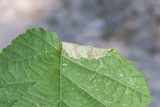Parornix devoniella (Stainton, 1850) Species
Last modified: Dec. 10, 2025, 2:09 p.m.
A common species throughout Belgium.
Details
- Classification
- Family: Gracillariidae > Subfamily: Gracillariinae > Tribus: Parornichini > Genus: Parornix > Species: Parornix devoniella
- Vernacular names
- Gewone zebramot (NL), Hazel slender (EN)
- First mention in Belgium
- De Fré Ch. 1858. Catalogue des Microlépidoptères de la Belgique. — Annales de la Société entomologique belge 2: 45–162. On page 147. view page
- Status
-
Native
Distribution
Imago
The forewing ground color is greyish with many small, inconspicuous, whitish striae along the costa and some brown spots near the inner margin. Identification without knowledge of the larval host plant is very difficult because of its close resemblance with the other Parornix species; study of the genitalia is necessary.
Caterpillar
Yellowish green with a light brown head capsule, the dark green intestinal tract is clearly visible; a row of four dark brown spots on the prothoracic plate, the two inner ones larger than the two outer ones (in contrast with the caterpillar of Phyllonorycter coryli which does not have such spots).
Mine
The first instar makes a small blotch on the underside of a leaf, mainly in a vein axil. At first, the central part of this blotch remains green because the caterpillar only consumes the outer parenchyma, where the blotch turns brown. Only in a later stage, the central parenchyma is eaten away also turning the mine into a very transparent blotch.
See also gracillariidae.net and bladmineerders.be.
Bionomics
Most of the blackish frass is concentrated in a corner of the mine. After leaving the mine the larva turns a leaf margin upwards and consumes the other plant tissues in this fold. Two successive folds are made.
Pupation within the leaf fold, falling between leaf litter in autumn.
The adults rest between the foliage during the daytime and become active towards dusk and during the night. They come to light.
Flight periods
The adults fly in two generations a year in May and again in July–August.
Observed on
- Host plant (species):
- Corylus avellana
The larvae feed on Corylus avellana.



